STEM is an educational curriculum that is gaining momentum rapidly in India. Rather than considering Science, Technology, Engineering, and Mathematics (STEM) as four standalone academic disciplines, it integrates them into a comprehensive and cohesive learning paradigm. STEM curriculums focuses on introducing interdisciplinary and application-based learning with real-world examples and get students interested in Applied Mathematics and Sciences from an early age.
Let’s break down STEM
Advertisement
- Science in STEM:Traditionally, science experiments are limited to schools and laboratories. However, STEM focused science lessons incorporate the application of scientific learning into everyday activities like cooking, gardening, etc. A STEM science activity at home can be as simple as observing an oscillating tomato tied to a string.
- Technology in STEM: Technology in STEM curriculums isn’t limited to sessions in computer labs drawing on Microsoft Paint. These days, kids use electronic toys powered by advanced technologies like AR and VR, mobiles, tablets daily. Technology supports accessibility, which provides a way for students to engage with content and empowers them to give their point of view.
- Engineering in STEM: STEM curriculums incorporate the engineering design process – identifying problems, evaluating options, and optimising solutions. STEM-based engineering education also includes hands-on activities that attempt to solve real-life problems.
- Math in STEM: Math classes in STEM curriculums encourage students to use concepts like algebra to find the shortest distance between an ice cream store and their homes, paying for a candy and counting the rest of the money, sharing a box of cookies equally amongst the class, and other such activities that highlight the practical importance of concepts taught in the classrooms. Q) What is the right age to introduce STEM to kids? While the answer to this question is subjective, we strongly believe that you can introduce STEM to kids as early as their second birthday. By introducing them to STEM at an early age (2 – 10 years), we are building the foundation for a bright future. Q) How can you build STEM skills in kids? Depending on the interests and age of the kids, you can pick the best activities that your kids would enjoy. The best practice for early education is to allow students to be actively engaged, and take the initiative in their learning. The best part about STEM education is that you can do it yourself outside classrooms. Kids can take part in daily activities like cooking and baking, playing musical instruments, shopping, gardening, etc. Kids get a chance to get a first-hand experience of how things are done in the real world. Government initiatives like Atal Innovation Mission and not-for-profit organisations like India STEM foundation are fostering STEM curriculums at different levels of education. Also, Indian edtect startups are revolutionising learning by merging physical and digital worlds.
